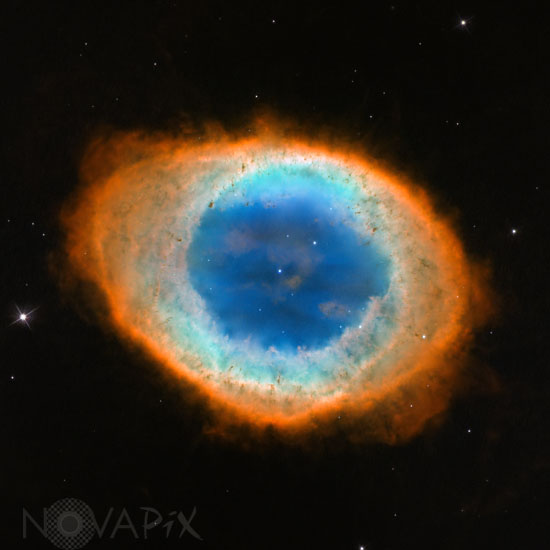Photo Agency - Astronomy - Space - Nature

The Ring nebula M57 in Lyra
author: Nasa/ESA/Novapix
reference: a-nep67-20010
Image Size 300 DPI: 27 * 27 cm
This close-up, visible-light view by NASA's Hubble Space Telescope reveals new details of the Ring Nebula.
The object is tilted toward Earth so that astronomers see the ring face-on. The Hubble observations reveal that the nebula's shape is more complicated than astronomers thought. The blue gas in the nebula's center is actually a football-shaped structure that pierces the red doughnut-shaped material. Hubble also uncovers the detailed structure of the dark, irregular knots of dense gas embedded along the inner rim of the ring. The knots look like spokes in a bicycle. The Hubble images have allowed the research team to match up the knots with the spikes of light around the bright, main ring, which are a shadow effect.
The Ring Nebula is a well-known planetary nebula, the glowing remains of a Sun-like star. The tiny white dot in the center of the nebula is the star's hot core, called a white dwarf.
The nebula is about 2,000 light-years away in the constellation Lyra. The structure measures roughly one light-year across.
The Hubble observations were taken Sept. 19, 2011, by the Wide Field Camera 3. In the image, the deep blue color in the center represents helium; the cyan color of the inner ring is the glow of hydrogen and oxygen; and the reddish color of the outer ring is from nitrogen and sulfur.
Keywords for this photo:
2013 - ASTRONOMY - DWARF - DYING STAR - EVOLUTION - HST - HUBBLE SPACE TELESCOPE - LYRA - M57 - NEBULA - NGC 6720 - PLANETARY NEBULA - STAR - WHITE DWARF -
Contact : Stéphane Aubin +33-(0)9-51-26-53-76
© Novapix - All rights reserved


